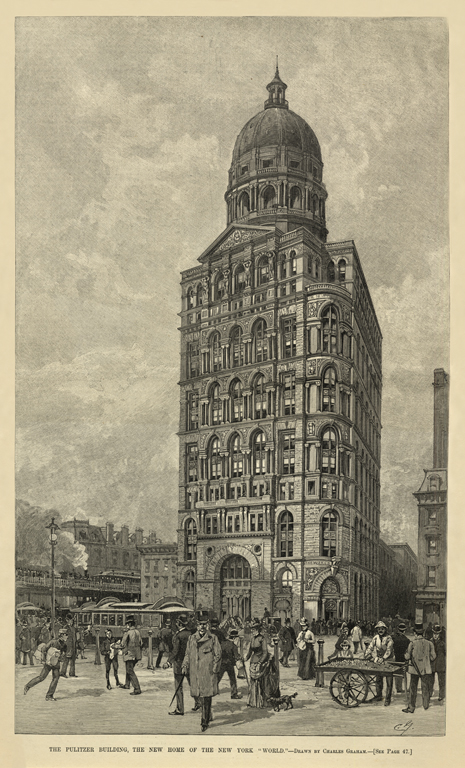The Skyscraper Museum is devoted to the study of high-rise building, past, present, and future. The Museum explores tall buildings as objects of design, products of technology, sites of construction, investments in real estate, and places of work and residence. This site will look better in a browser that supports web standards, but it is accessible to any browser or Internet device.
World Building

Drawing of the World Building, Harper's Weekly, January 18, 1890.
Completed in December 1890, the World Building, officially called the Pulitzer Building, was an expression of the ambitions and business genius of its publisher Joseph Pulitzer. At a height of 309 feet to the top of the dome, the World's new home became the highest building in the city and the tallest office building in the world.
Pulitzer, a Hungarian immigrant who had first arrived in New York in 1864 and fought in the Civil War, had his initial success the newspaper business in St. Louis. He purchased the New York World from financier Jay Gould in 1883 when the ailing paper had a daily circulation of only 22,000. A year later, Pulitzer had quadrupled the circulation, and by 1898 was selling a half million copies a day.
In 1889, as the Times was completing its imposing headquarters on Printing House Square, Pulitzer planned a new home for the World that would outshine and overtop all his competitors. The site he acquired was on the northeast corner of Park Row and Frankfort Street overlooking City Hall Park. Pulitzer envisioned a dome that would symbolize both the ascendance of his paper and, as he professed, the highest ideals of journalism: liberty, justice, democracy and "true Americanism." Indeed, the World's 5-floor gilded dome, which housed the writers, editors, and Pulitzer's private office, lifted the publisher high above the city. In its booklet printed for the building's debut, the paper effused:
"From Jersey's shores, from Brooklyn Heights, from the beach of Staten Island, from points far remote, it is first discerned as one approaches New York looming above the busy metropolis, above Trinity's lofty spire, above the tall towers and high roofs of its neighbors-a giant among the giants."
In an architectural competition, Pulitzer selected George B. Post, architect of the Times Building, to design his tower. Some stories claim that Post won the commission by wagering $20,000 with Pulitzer that he could complete the project for its $1,000,000 budget. He got the job, but lost the bet, since the costs reached $2,000,000. No expense was spared on the elaborate fa�ade of red sandstone, Renaissance ornament, and figurative sculpture that gave the tower an Old World character and made it look to be made of masonry rather than the advanced metal-cage construction that Post used within the walls.
The language with which the World celebrated its new head-quarters was as richly laden with rhetoric as the building itself:
"There is a sermon in these stones: a significant moral in this architectural glory. Fidelity to the Public Welfare, fearless opposition to the Wrong and vigorous defence (sic) of the Right, a persistent aspiring to loftier Ideals are the lessons it teaches."
